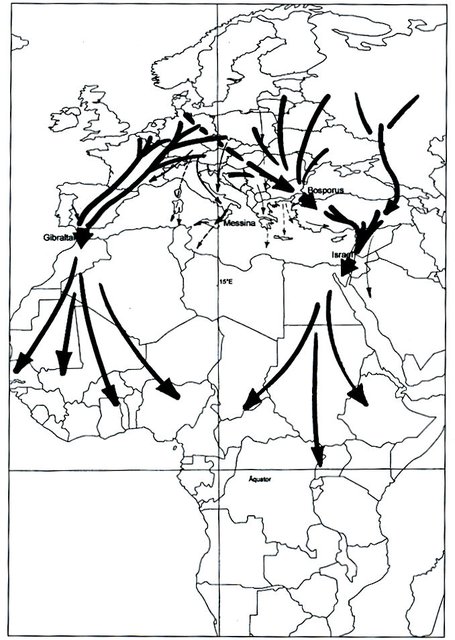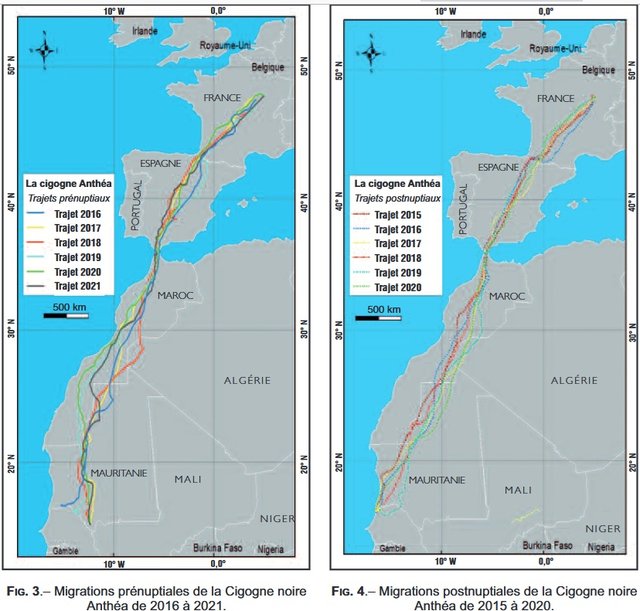2020
WHITE STORKS (!)
Causes and consequences of facultative sea crossing in a soaring migrant.
1. Studying the causes and consequences of route selection in animal migration is important for understanding the evolution of migratory systems and how they may be affected by environmental factors at various spatial and temporal scales. One key decision during migration is whether to cross 'high transport cost' areas or to circumvent them. Soaring birds may face this choice when encountering water-bodies where convective updrafts are weak or scarce.
Crossing these water-bodies requires flying using energetically costly flapping flight, while circumventing them over land permits energetically cheap soaring.
2. We tested how several atmospheric factors (e.g. wind, thermal uplift) and geographic , seasonal and state-related factors (sex and age) affected route selection in migrating white storks Ciconia ciconia. We used 196 GPS tracks of 70 individuals either crossing or circumventing the north-easternmost section of the Mediterranean Sea, over Iskenderun Bay in southern Turkey.
3. We found that
westward and southward winds promoted a cross-bay journey in spring and autumn, respectively, acting as tailwinds. Also, overall weaker winds promoted a sea crossing in spring. Sea crossing was associated with flapping flight and higher values of overall dynamic body acceleration and resulted in higher ground speed than travel over land.
4. The combined environmental conditions and the effects of route selection on movement-related energy costs and speed were likely responsible for an increase in the time spent flying and distance travelled of migrating storks that decided to cross the bay during spring.
Notably, daily travel distances of spring migrants crossing the bay were 60 km longer than those of land-detouring birds, allowing them to reach their destination faster but likely incurring a higher energetic flight cost. No such benefit was found during autumn.
Paolo Becciu, Rotics, S., Horvitz, N., Kaatz, M., Fiedler, W., Zurell, D., Flack, A., Florian Jeltsch, Wikelski, M., Nathan, R., & Sapir, N. (2020). Causes and consequences of facultative sea crossing in a soaring migrant.
Functional Ecology, 34(4), 840–852.
https://doi.org/10.1111/1365-2435.13539
Mihaela Ciobotă, Dumitru Murariu, and Andreea Ciobotă "
Traditional Fish Pond Management Provides Reliable Foraging Opportunities for Migrating Black Storks in Romania," Ardea 108(2), 191-201, (14 December 2020).
https://doi.org/10.5253/arde.v108i2.a10
ABSTRACT
Migrant water birds such as Black Storks Ciconia nigra have progressively started capitalizing on man-managed ecosystems during migration. Behavioural and ecological studies at stopovers are thus key to deliver comprehensive conservation policies. To be able to improve stopover potential for one of the main Black Stork fall passage sites in central Romania, the Dumbrăviţa fishing complex, we analysed the species' foraging behaviour in relation to management of water levels and human activities. Afternoon feeding sessions were recorded weekly during two consecutive autumn migration periods in August–September 2017 and 2018. We used focal and scan sampling methods to quantify behavioural patterns based on 168, 10-minute feeding bouts between 16:00 and 18:00. The selection of foraging areas was contingent upon drainage practices and biased towards vegetated sectors of ponds. The time at which the storks started foraging was strongly correlated with the cessation of the daily fish harvest. Hunting strategies involved grabbing (visual) and water probing (tactolocation), the first prevailing in terms of frequency and time allotment and the latter mainly being used in shallow, muddy areas. Until now, traditional fish farming has unintentionally catered to Black Stork feeding preferences. We put forward several long-term management suggestions to secure the stopover potential for Black Storks at Dumbrăviţa.


